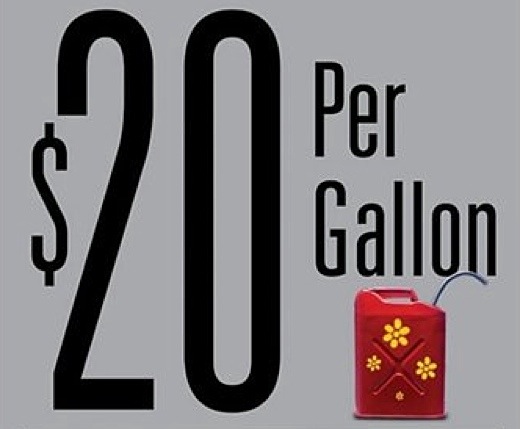If you hated gas at $4 per gallon, imagine it at $20
Review by James Pressly on 4 August 2009 in Bloomberg News
Presidential candidates called for a gas-tax “holiday.” Sales of SUVs plunged. Commuters rediscovered trains, buses and bikes. Americans drove 100 billion fewer miles in the 12 months through October 2008 than they did a year before.
From http://www.amazon.com/20-Per-Gallon-Inevitable-Gasoline/dp/0446549541
That was just a glimpse of things to come, says Christopher Steiner in “$20 Per Gallon,” a surprisingly upbeat look at how rising gasoline prices “will change our lives for the better.”
From the outset, Steiner dismisses the tiresome debate about whether oil production will really peak, plateau and decline. Even Boone Pickens, who made a fortune on oil and gas, says we must learn to live with peak oil.
With supplies of cheap, easy-to-extract oil dwindling and demand expected to rise in lockstep with the planet’s growing middle class, prices in the long haul can only go up, as economist Jeff Rubin argues in his book, “Why Your World Is About to Get a Whole Lot Smaller.”
“$20 Per Gallon” takes peak oil as a given. “This book is the next step in the conversation,” Steiner says.
And a fun discussion it is, as the author lays out how everyday life might look as gasoline prices climb ever higher. In place of Chapter 1 and Chapter 2, Steiner gives us Chapter $6 and Chapter $8, leading up by $2 increments to a $20 Epilogue. Gimmicks don’t usually appeal to me; this one works.
We often overlook the fact, Steiner says, that the price of oil affects much more than just the cost of filling up your Audi Q7.
“It’s the bricks in your walls, the plastic in your refrigerator, the asphalt on your roads, the shingles on your roof, the synthetic rubber in your ball,” he writes with characteristic bounce.
Food to Bridges
Since the entire economy runs on oil, Steiner weaves together themes ranging from the future of the automobile to the sustainability of our food network.
He did his homework. A civil engineer and staff writer at Forbes magazine, he interviewed people -- from economists to airline pilots -- who have calculated how oil at various prices will change where we live, how we travel and what we eat.
He rides shotgun in UPS package trucks that run on batteries or energy stored in pressurized tanks of hydraulic fluid. He watches workers swarm over the scaffolding surrounding a Boeing 787 Dreamliner, the first commercial plane with a fuselage and wings made mainly of plastic composites to reduce weight and conserve fuel. He travels to a factory on the Iowa prairie where corn will be turned into biodegradable plastic.
Battery Swap
Elsewhere, Steiner explains how a former SAP AG executive founded Better Place, a company that wants to be “the Exxon Mobil of the electric car world.” Drivers would buy the cars without batteries and pay Better Place a monthly fee to supply the juice. When you’re running low, just pull into a Better Place depot that will swap in a fully charged battery.
So what will happen as gasoline prices tick ever higher? Here’s a smattering of Steiner’s predictions:
At $6 a gallon, Americans will embrace diesel engines. At $8, many airlines will shut down, leaving Southwest Airlines Co. and JetBlue Airways Corp. as the dominant domestic carriers.
At $10, car ownership rates will plummet. At $12, exurbs will start becoming ghost towns. At $14, Wal-Mart Stores Inc. will die; its business model is built on cheap oil.
At $18, Americans might get what Europeans have enjoyed for years: high-speed trains. And as the price creeps up to $20 a gallon, the U.S. may finally frame a comprehensive energy plan.
Purer Air
Far from hurling us into a new Dark Age, high oil prices will usher in a cleaner, safer future, Steiner argues. Like Rubin, he imagines lost jobs returning to U.S. shores and pictures us breathing purer air and eating healthier, locally grown food. Though he gets a bit too utopian and speculative for my taste, he does offer evidence that technology already exists to effect such changes.
Steiner is good at explaining how things work and seeding the text with interesting facts: Did you know that garbage trucks get an average of 2.8 miles per gallon? And he’s realistic about how hard it will be to end our love affair with cars and planes.
“People will cling to their steering wheels and their airline seats until their fingers are pried off by sheer financial behest,” he writes.
“$20 Per Gallon: How the Inevitable Rise in the Price of Gasoline Will Change Our Lives for the Better” is from Grand Central in the U.S. (275 pages, $24.99).
No comments :
Post a Comment